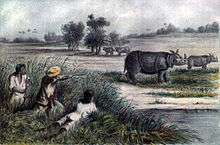Rhinoceros sondaicus annamiticus
Rhinoceros sondaicus annamiticus[2]is a critically endangered subspecies of the Rhinoceros sondaicus (the Javan rhinoceros) that formerly lived in Laos, Cambodia, Thailand and Malaysia and may still survive in Vietnam. The term Annamiticus derives from the Annamite name of the Indochinese Mountains in Indochina, part of the distribution of this species, also known as the Vietnamese Javan rhinoceros or simply the Vietnamese rhinoceros.
| Rhinoceros sondaicus annamiticus | |
|---|---|
| Scientific classification | |
| Kingdom: | Animalia |
| Phylum: | Chordata |
| Class: | Mammalia |
| Order: | Perissodactyla |
| Family: | Rhinocerotidae |
| Genus: | Rhinoceros |
| Species: | |
| Subspecies: | R. s. annamiticus |
| Trinomial name | |
| Rhinoceros sondaicus annamiticus Heude, 1892 | |
Rhinoceros sondaicus annamiticus once lived across South China, Vietnam, Cambodia, Laos, Thailand, and Malaysia. The subspecific name R.s. annamiticus is derived from the Annamite Mountain Range in Southeast Asia, which was part of its range. In 2006, a single population, estimated at fewer than 12 remaining rhinos, lived in an area of seasonal tropical forest of Cat Tien National Park in Vietnam. Genetic analysis suggested this subspecies and the Indonesian Javan rhinoceros last shared a common ancestor between 300,000 and 2 million years ago.[3][4] The last known individual of this population was shot by a poacher in 2010, and some conservation groups believe that the subspecies is extinct.[5]
Threats

As with many other species, the two main factors in the decline of the Vietnamese Javan rhinoceros populations has been loss of habitat combined with over-hunting. Poaching for horns, a problem that affects all rhino species. The horns have been a traded commodity for more than 2,000 years in China, where they are believed to have healing properties. Because the Vietnamese Javan rhinoceros's final range encompassed an area of human poverty, it is difficult to convince local people not to kill an animal that could be sold for an enormous sum of money.[6]
References
- "Rhinoceros sondaicus (Javan Rhinoceros)". IUCN Red List of Threatened Species.
- "Catalogue of Life : Rhinoceros sondaicus annamiticus Heude, 1892". www.catalogueoflife.org.
- van Strien, N.J., Steinmetz, R., Manullang, B., Sectionov, Han, K.H., Isnan, W., Rookmaaker, K., Sumardja, E., Khan, M.K.M. & Ellis, S. 2008. Rhinoceros sondaicus. In: IUCN 2008. IUCN Red List of Threatened Species.
- Fernando, Prithiviraj; Gert Polet; Nazir Foead; Linda S. Ng; Jennifer Pastorini; Don J. Melnick (June 2006). "Genetic diversity, phylogeny and conservation of the Javan rhinoceros (Rhinoceros sondaicus)". Conservation Genetics. 7 (3): 439–448. doi:10.1007/s10592-006-9139-4.
- Gersmann, Hanna (October 25, 2011). "Javan rhino driven to extinction in Vietnam, conservationists say". The Guardian. Retrieved 25 October 2011.
- Corlett, Richard T. (2007). "The Impact of Hunting on the Mammalian Fauna of Tropical Asian Forests". Biotropica. 39 (3): 202–303. doi:10.1111/j.1744-7429.2007.00271.x.
